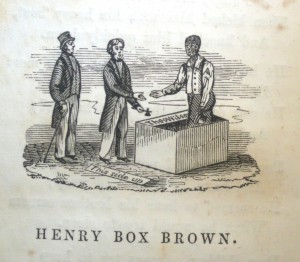 Henry Box Brown (b. 1816) escaped lifelong slavery in Virginia by shipping himself in a box (with the help of white and African-American abolitionists) to Philadelphia in 1849. One of the few primary sources detailing his breathtaking escape to freedom is the children’s book Cousin Ann’s Stories for Children. Written in 1849 by Quaker abolitionist and pioneer female physician Ann Preston (1813-1872), her account conveys in simple but deft language, Brown’s death-defying journey:
Henry Box Brown (b. 1816) escaped lifelong slavery in Virginia by shipping himself in a box (with the help of white and African-American abolitionists) to Philadelphia in 1849. One of the few primary sources detailing his breathtaking escape to freedom is the children’s book Cousin Ann’s Stories for Children. Written in 1849 by Quaker abolitionist and pioneer female physician Ann Preston (1813-1872), her account conveys in simple but deft language, Brown’s death-defying journey:
The box was three feet long, two feet eight inches deep, and twenty-three and a half inches wide. Then, he got a kind man to send word to a trusty friend in Philadelphia, that the box would be sent on the cars to Philadelphia on a certain day. On the top of the box was written in large black letters, ‘this side up with care.’ When it was nearly time for the cars to start, Henry took a bladder of water, some biscuit, and a large gimlet, and got into his box. Then a man nailed down the top, and porters took the box to the cars, thinking … that it was a box of goods. It was very hot in the box, and Henry could hardly breathe, there was so little air. But he made up his mind to die rather than make a noise … Part of the way he travelled by water, and when the box was put on the steamboat, it was placed so that Henry’s head and back were down … He lay in this way, while the boat went twenty miles, and it nearly killed him. He staid in his little box-house twenty-six hours; but could not eat any of his biscuit, and instead of drinking the water, he used it to bathe his hot face.
Thankfully, Henry survived, and he emerged out of his box at the home of an abolitionist. His jubilant emergence is captured in this wood-engraved illustration from Cousin Ann’s Stories, as well as in a political cartoon, and two broadsides held at AAS. Brown, himself, described his journey in the Narrative of Henry Box Brown, first published in Boston in 1849.
Ann Preston concludes her story about Henry Box Brown with a profound comment on the meaning of true heroism:
We call people heroes who do something that is brave and great, and Henry is a hero.
Henry Box Brown’s story has been told to a whole new generation of young readers by writer Ellen Levine and illustrator Kadir Nelson’s evocative picture book Henry’s Freedom Box (2007), which was named a Caldecott Honor Book. Levine and Nelson skillfully convey the sadness and hope of Henry’s story, and the book provides an incisive introduction to the historical understanding of American slavery for today’s children.
Primary Sources on Henry Box Brown at AAS:
Escape From Slavery of Henry Box Brown in a Box 3 feet and 1 inch long, 2 feet wide, 2 feet and 6 inches high. (Boston, ca. 1849 or 1850) Broadside.
Preston, Ann. Cousin Ann’s Stories for Children. (Philadelphia, 1849). Children’s book.
The Resurrection of Henry Box Brown at Philadelphia. (Boston, 1850). Political cartoon.

Cool
Hello Laura, I recently published Cousin Ann’s Stories for Children (Inner Light Books, 2010) and was pleased to see your comment on Henry Box Brown. James Miller McKim, who published the original of Cousin Ann, was in the room when the box was opened. I am wondering if any account of Box Brown’s escape was published prior to Ann Preston’s. Do you have any ideas about this? Thanks, Richard Beards